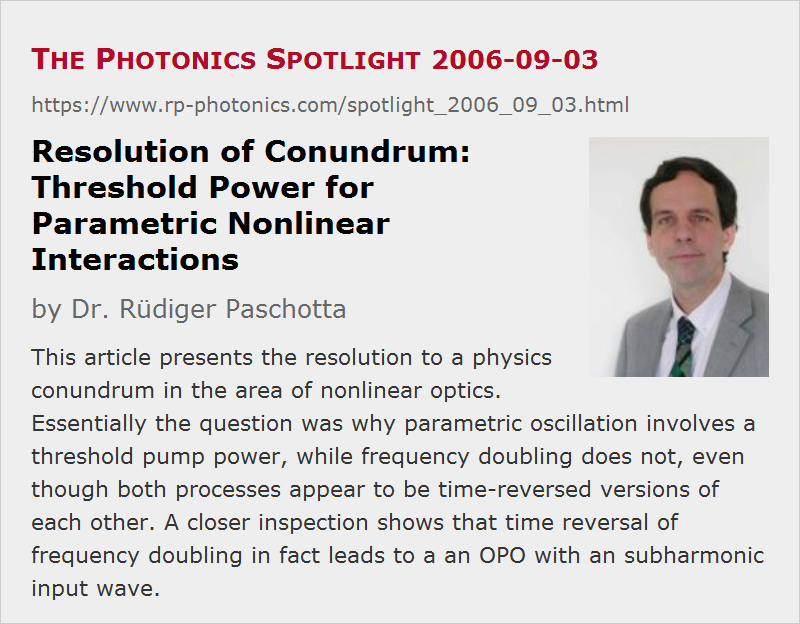Resolution of Conundrum: Threshold Power for Parametric Nonlinear Interactions
Posted on 2006-09-03 as a part of the Photonics Spotlight (available as e-mail newsletter!)
Permanent link: https://www.rp-photonics.com/spotlight_2006_09_03.html
Author: Dr. Rüdiger Paschotta, RP Photonics Consulting GmbH
Abstract: This article presents the resolution to a physics conundrum in the area of nonlinear optics. Essentially the question was why parametric oscillation involves a threshold pump power, while frequency doubling does not, even though both processes appear to be time-reversed versions of each other. A closer inspection shows that time reversal of frequency doubling in fact leads to a an OPO with an subharmonic input wave.

Ref.: encyclopedia articles on parametric amplification, optical parametric oscillators, frequency doubling, etc.
On 2006-07-30, the Photonics Spotlight presented a physics conundrum: the question was essentially why parametric oscillation involves a threshold pump power, while frequency doubling does not, even though both processes appear to be time-reversed versions of each other.
The resolution of this issue is found through a closer inspection of what time reversal really leads to. Consider a resonant frequency doubler operated at a rather low pump power level. It will generate some second-harmonic light, but leaves much of the pump light unconverted. Now imagine the time-reserved situation. This looks like a degenerate optical parametric oscillator (OPO), converting some higher-frequency pump light into lower-frequency light. It is essential not to overlook that the unconverted pump light leaving the frequency doubler now appears as subharmonic light which forms a second input of the OPO. Only with this additional subharmonic input, the OPO can convert light power at arbitrarily low power levels. If you omit this input, you don't have a time-reversed situation of a frequency doubler any more, and therefore it is not surprising that there is then a threshold power involved.
This article is a posting of the Photonics Spotlight, authored by Dr. Rüdiger Paschotta. You may link to this page and cite it, because its location is permanent. See also the RP Photonics Encyclopedia.
Note that you can also receive the articles in the form of a newsletter or with an RSS feed.
Questions and Comments from Users
Here you can submit questions and comments. As far as they get accepted by the author, they will appear above this paragraph together with the author’s answer. The author will decide on acceptance based on certain criteria. Essentially, the issue must be of sufficiently broad interest.
Please do not enter personal data here; we would otherwise delete it soon. (See also our privacy declaration.) If you wish to receive personal feedback or consultancy from the author, please contact him e.g. via e-mail.
By submitting the information, you give your consent to the potential publication of your inputs on our website according to our rules. (If you later retract your consent, we will delete those inputs.) As your inputs are first reviewed by the author, they may be published with some delay.
 |




If you like this page, please share the link with your friends and colleagues, e.g. via social media:
These sharing buttons are implemented in a privacy-friendly way!